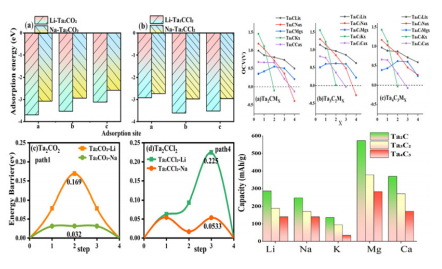"ORISE" supercomputer facilitates the study of novel 2D cathode materials
The electrochemical properties of new two-dimensional materials are one of the key problems in the field of new energy. Recently, researchers from the High Performance Department of our Center cooperated with researchers from Wenzhou University to systematically evaluate the application of new 2D tantalum (Ta) -based MXene (a class of 2D inorganic compounds) materials in metal ion battery cathode materials, relying on the center's autonomous and controllable "ORISE" supercomputer. The experimental results show that lithium, sodium, potassium, magnesium and calcium ions have ultra-low diffusion barrier on the surface of Tan+1Cn MXenes, which is expected to achieve ultra-fast charging and discharging of high-performance battery materials. And Ta2C MXene has a large open circuit voltage (OCV) and maximum capacity, making it available as an ideal anode material for lithium, sodium, potassium, magnesium, and calcium ion batteries. In addition, Tan+1CnO2 MXenes also have a stable electronic structure, good adsorption capacity and diffusion rate. These findings may provide theoretical guidance for the design of novel MXene-based composite energy materials.
The research results were accepted by Inorganic Chemistry Frontiers (JCR Q1). The first author of the paper is Guo Jiayi, a joint graduate student of Wenzhou University and CNIC. The corresponding authors are associate Professor Ma Yingjin of CNIC, Associate Professors Xu Lina, Xiao Hongping, and Fang Guoyong of Wenzhou University, separately.
This work was supported by the National Natural Science Foundation of China, the Youth Innovation Promotion Association of CAS, and the Strategic Priority Research Program of the Chinese Academy of Sciences.

Fig. Theoretical benchmarks of Ta-based MXene materials in metal ion battery
Related work:
Structural and Electrochemical Properties of Tan+1Cn MXene Anode Materials for Metal-Ion Batteries. J. Guo, D. Hu, C. Bai, L. Xu*, H. Xiao*, Q. shi, X. Li, X. Chen, Y. Ma* and G. Fang*, Inorg. Chem. Front., 2024, DOI:10.1039/D3QI02335D.
